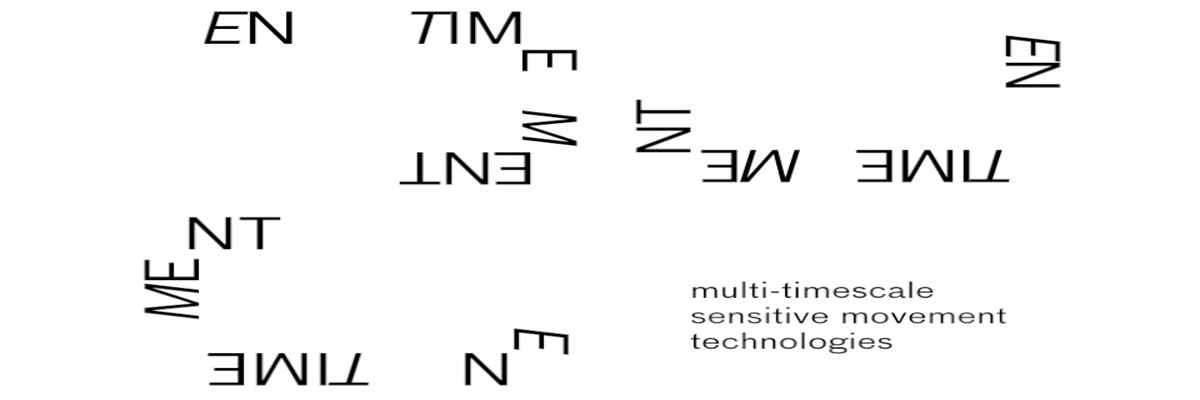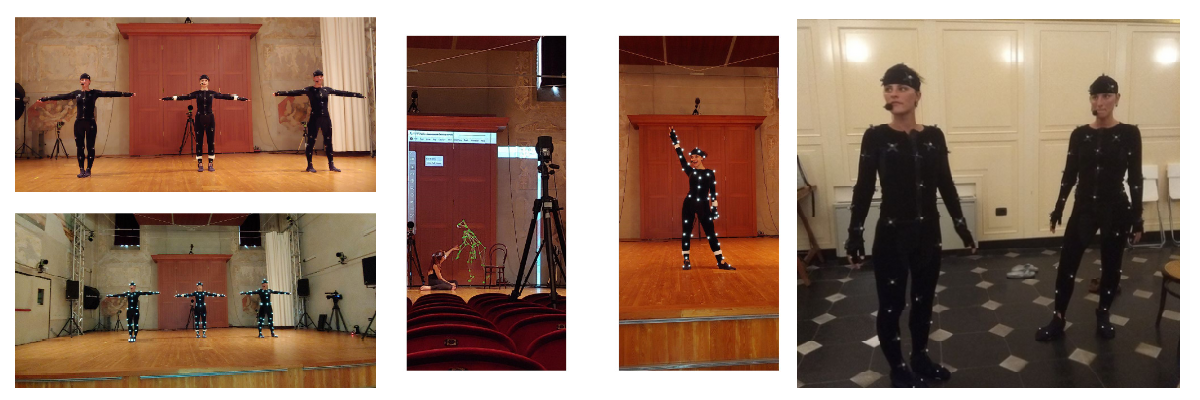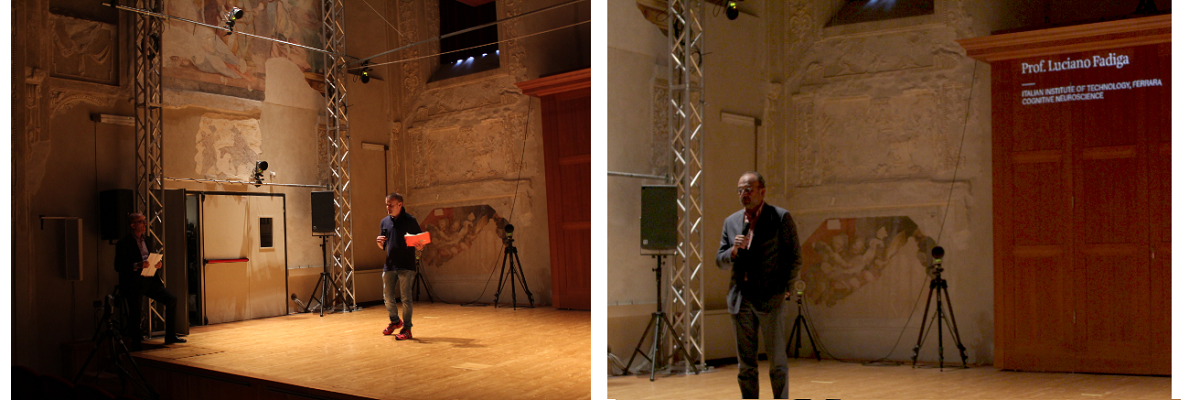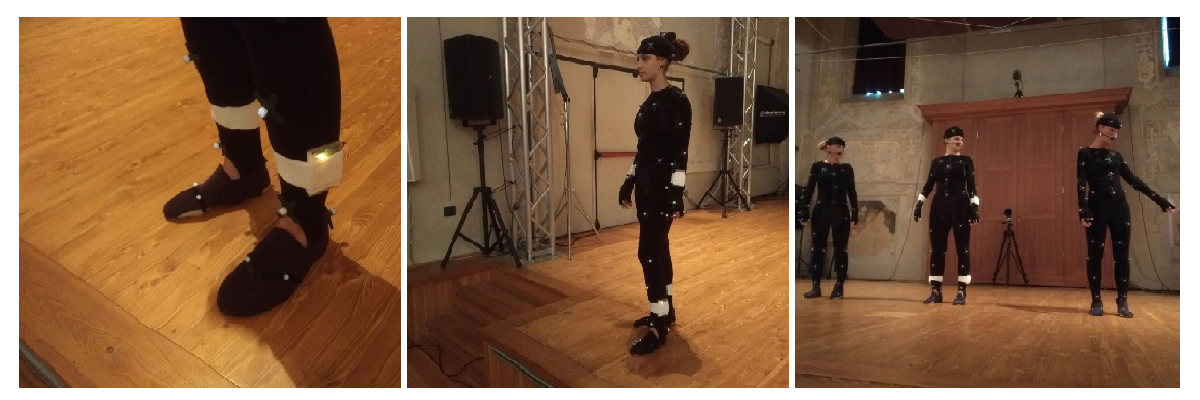Technological objectives:
- Objective 5: Developing computational methods for the analysis and prediction of movement qualities from behavioral signals, based on multi-layer parallel processes at non-linearly stratified temporal dimensions. As a result, we expect the project will produce a library of software modules for the EnTimeMent platform, providing the measurement tools needed for enabling automatic measurement, prediction, and entrainment of movement qualities at both the individual and group level.
- Objective 6: Supporting experiments and proof-of-concepts through a hardware and software platform (the EnTimeMent experimental platform), towards the experimentation of novel generations of time-aware motion perception and prediction systems, by enabling: (i) real-time and synchronized data capture from multiple and different input devices; (ii) automated measurement, processing, and prediction of qualities of movement exploiting the theoretical conceptual framework, and in particular the multiple non-linear stratified temporal dimensions; (iii) delivery of multisensory feedback through multiple output devices, including sonification. The platform needs to be scalable to different scenarios, ranging from controlled laboratory environments to ecological realistic settings. Besides common input devices such as video cameras and wireless on-body microphones, the EnTimeMent platform will support commercial as well as prototypes of motion capture systems, Inertial Measurement Units, devices for real-time physiological data acquisition (e.g., EMG and Functional Near Infrared Spectroscopy [fNIRS]).
- Objective 7: Developing three (3) proofs-of-concepts exploiting both the envisaged platform and libraries – in three different real-world scenarios: healing and support of everyday life in disabled persons, human interaction with non-anthropomorphic robots (living architecture), and sensory-motor entrainment and commitment in sport, dance and music. The three proof-of-concepts are selected to cover a broad variety of real life contexts, so that they can fully demonstrate the functionalities of the developed technologies. The expected result is to demonstrate the effectiveness of the technology from the perspective of its broad future exploitation.
EnTimeMent project objectives...
EnTimeMent project objectives description...
EnTimeMent measurable objectives can be summarised as follows:
EnTimeMent project scientific objectives...
EnTimeMent project technological objectives...
EnTimeMent project community-building objectives...
EnTimeMent project scenarios...
Community-building objectives:
- Objective 8: Building a novel scientific interdisciplinary community leading the transformation of the current generation of motion capture systems into a novel generation of time-aware motion perception and prediction systems. Disciplines include computer science and engineering, human movement and sport sciences, biomechanics, neuroscience, cognitive science, psychology, performing arts. Computer science can contribute to ground conceptual models on strong quantitative evidence; this interdisciplinary framework will contribute to ground computational methods on stronger theoretical bases. EnTimeMent will strengthen interactions between these research areas by means of cross-disciplinary collaborations and public community-building initiatives (e.g., in existing as well as new conferences, workshops, scientific contests) aiming at identifying common research challenges and at addressing them through a shared research methodology.
- Objective 9: Building an interdisciplinary community of scientists and technologists around the core concept of EnTimeMent, that is, technologies that foster time-aware motion perception and prediction systems at individual as well as group levels, by involving key stakeholders such as startup incubators and innovation hubs. Such a community will cover and address, on the one hand, a natural but strongly innovative evolution of the motion capture and movement analysis research area dealing with adaptive and predictive interfaces, and, on the other hand, will be transversal with respect to technologies used in other areas, for example, affective computing, sport technologies, therapy and rehabilitation, IoT, domotics, gaming, and entertainment.
- Objective 10: Building a community of stakeholders, including companies and SMEs, interested in the concept of time-aware movement perception and prediction technologies and willing to bring such technologies into their services or products (e.g., companies willing to deploy innovative technological solutions for the EnTimeMent application scenarios). Such a community would enable the project to reach a concrete societal and economic impact. The building community actions will include public initiatives (e.g. hackathons, contests, users workshops) aiming at attracting, engaging and integrating the diverse types of stakeholders including incubation ecosystems for SMEs, for a rich exchange and convergence of the project with external stakeholders.
The success of the project with respect to the objectives listed above will be assessed through studies involving selected user communities exposed to the project enabling technologies in the selected scenarios. Assessment will concern the effectiveness of the technology-supported activities. To this aim, a detailed collection of success measures will be identified and defined. Incubators and innovation hubs for ICT SMEs and stakeholders in the fields of disability and sports technologies (e.g. (www.disabilityinnovation.com/content/projects-and-activities and www.wylab.net/) will be active members of the Stakeholder Panel and will play active roles in co-organizing community-building initiative; two major hospitals will support concretely the experimentation of the healing and chronic pain scenarios in everyday life, providing access to real user populations within a careful management of ethical issues.
EnTimeMent project objectives...
EnTimeMent project objectives description...
EnTimeMent measurable objectives can be summarised as follows:
EnTimeMent project scientific objectives...
EnTimeMent project technological objectives...
EnTimeMent project community-building objectives...
EnTimeMent project scenarios...
|
The mother’s arm is moving upwards: how are we able to see in her gesture the tender sweetness leading her to caress the cheek of her sleeping child or the inner violence preparing to hit the soldier’s cheek? How can we foresee in the heavy murderer’s hand movement a slight faltering revealing his fragile uncertainty in finishing his task, how can we measure the hesitation of the woman’s arms closing to protect her crying, in resonant dialogue with the bodies moving around her? |
|
|
EnTimeMent project objectives... EnTimeMent project objectives description...
|
|
|
EnTimeMent measurable objectives can be summarised as follows: EnTimeMent project scientific objectives... EnTimeMent project technological objectives... EnTimeMent project community-building objectives... EnTimeMent project scenarios...
|
|
|
Scenario 1: Healing with multiple times |
|
Research questions addressed: How can multi-time EnTimeMent technologies improve everyday life communicative and prosocial skills in severely disabled persons with low or no verbal capabilities? |
|
Narrative description: Giorgio is a 4 year-old child with a severe case of dystonic cerebral palsy. As a consequence, he is not able to control his movements, feed himself or effectively communicate with others, which threatens learning and participation. His mom Francesca struggles with her child’s condition which she hasn’t still fully accepted. Therapists know the situation is extremely complex, with the family living far from the hospital, in an area where social assistance and services are less effective. In cases as severe as Giorgio’s, in which a complex rehabilitation project takes place as the person is still growing up, the healing process becomes a life project, with multiple aims and goals unfolding in multiple temporal dimensions. The rehabilitation team has leveraged a “home-care-unit” that affords the family to live autonomously while having Giorgio monitored by the EnTimeMent technology , and allows to read Giorgio’s body communicative signals at multiple temporal scales, in order to: at a lower temporal scale, enhance movement control by interpreting bodily sensorimotor and muscular signals to regulate and better tune care and assistance; Improve emotion regulation by decoding affective bodily signals and providing most appropriate responses and care. at a middle temporal scale, foster attention and motivation by interpreting bodily signals of vigilance, focus and interest; Improve control of bodily movements while learning daily-life processes such as drinking; Support emotion regulation by interpreting residual bodily intentional communication at a higher temporal, foster planning and control of complex activities such as play and social interaction by decoding participative signals; Enhance metacognitive processes by reading resilience signals. |
|
Scenario 2: Chronic Musculoskeletal Pain Management with multiple times |
|
Research question addressed: Can the modeling and enhancement of diverse temporal-scales of movement in chronic musculoskeletal pain facilitate self-management and functional activity? |
|
Narrative description: Since developing chronic back pain, Paul’s attention is constantly on pain and on fearing increased pain or damage. He no longer understands what his body can and cannot do, or learn from experiencing movement. When he tackles physical tasks, his concern is about pain so he rushes them, feels no satisfaction at completing them and often feels defeated by increased pain. His central nervous system is ‘stuck’ on pain. The newly released EnTimeMent motion capture system captures his movements at different temporal-scales through the day and sonifies it. Each temporal-scale of movement carries particular meaning. Low-level temporal dynamics of Paul’s taking a book from a shelf tells him how far he stretches and how much more he could move, constraining anxiety. Longer temporal aspects of his movement, outside his awareness, represent task achievement (e.g. washing his car) and remind him to take regular breaks before pain builds up. Even longer temporal dynamics, over weeks and months, show him progress in his capabilities, while increased fluidity of his movement reflects reduced anxiety and increased confidence. This progress sustains him during setbacks and higher pain days, as it reminds him how to build activity again, and his central nervous system is processing normal messages about movement. We will investigate new computational models that capture these different temporal dynamics of movement and the multiple temporal phenomena characterising them and their interactions (kinematics, muscle activity, respirations, brain activation) and transform them into sound enriched by metaphorical musical structures that through embodiment enhances the awareness of movement capability, and provides a path for taking back control from pain. Such computational models will also aim to model even lower temporal dynamics, capturing protective and avoidant movement responses (habits outside awareness) at physiological and neural levels that maintain pain. We will aim at developing new metrics of progress (e.g. individual motor signature as in Słowiński et al. 2016) based on these different temporal-scales. Such computational models can inform the design of rehabilitation for chronic pain self-management supported by the novel multi-temporal multi-modal EnTimeMent motion capture technology. We will also explore how it can be used to facilitate communication between the person with chronic pain and her home-carer and healthcare staff to facilitate learning of management skills. |
|
Scenario 3: Dancing with multiples times |
|
|
Research questions addressed: How are individual and group motor signatures of dancers characterized at multiple time scales during improvisation among them and with non-anthropomorphic partners? |
|
|
Narrative description: A group of dancers engaged in a performance with non-anthropomorphic dancing partners perform joint improvisation sequences, playing with social roles (leader, follower, improvising), emotional gesture qualities (hesitant, aggressive etc.) and physical/ghost presence of their dancing partners. Dancers perform in an architectural space, which can be interactively manipulated by sound (interactive movement sonification, to enhance the communication at multiple temporal scales) or light (e.g., in the light or in the dark), and which can even be structurally transformed by means of interactive mobile scenery (e.g. a theatre stage technologically equipped simulating a future living architecture). Using the EnTimeMent motion analysis system, biological and social signals are recorded at multiples time scales, from milliseconds (e.g., EMG) to seconds (e.g., MOCAP) to minutes (e.g., breathing), allowing the computation of Individual Motor Signatures of each dancer (IMS), Group Motor Signature (GMS), together with their dynamics at their respective temporal scales, as well as entrainment, saliency, and prediction of qualities. Applying the new Curiosity-based EnTimeMent Learning Algorithm (CELA), relevant individual and social performance qualities are extracted simultaneously. Concrete instances of this group interaction scenario will be developed, from dance to sports, fitness, wellness, and entertainment group activities. |
|
|
EnTimeMent project objectives... EnTimeMent project objectives description...
|
|
|
EnTimeMent measurable objectives can be summarised as follows: EnTimeMent project scientific objectives... EnTimeMent project technological objectives... EnTimeMent project community-building objectives... EnTimeMent project scenarios...
|
|
|
EnTimeMent aims at a radical change in scientific research and enabling technologies for human movement qualitative analysis, entrainment and prediction, based on a novel neuro-cognitive approach of the multiple, mutually interactive time scales characterizing human behaviour. Our strategy facilitates the development of computational models for automated detection, measurement, and prediction of movement qualities. These models, based on behavioural signals, work on multi-layered parallel processes at nonlinearly stratified temporal dimensions, offering new prospects for human movement analysis.EnTimeMent's innovative and time-responsive technologies operate on multiple time scales, introducing a new dimension to motion capture and movement analysis systems. Our goal is to create time-aware multisensory motion perception and prediction systems. Our proposed models and technologies undergo systematic testing and refinement through a range of controlled and ecological experiments. This includes action prediction in a laboratory setting and in the context of dyadic and small group interactions. EnTimeMent's research scenarios span several sectors such as healthcare, performing arts (e.g., dance), sports, and entertainment group activities. We also engage with living architectures where applicable. We're dedicated to promoting community-building and exploitation through practical initiatives. This involves creating a network of users and stakeholders, innovation hubs, and SME incubators to provide a basis for project continuity and potential market expansion post-project. |
|
|
Project Objectives Description
|
|
|
EnTimeMent measurable objectives can be summarised as follows:
|







